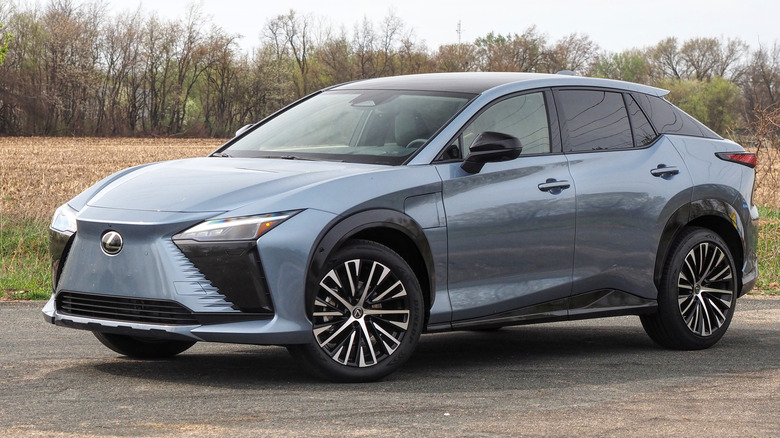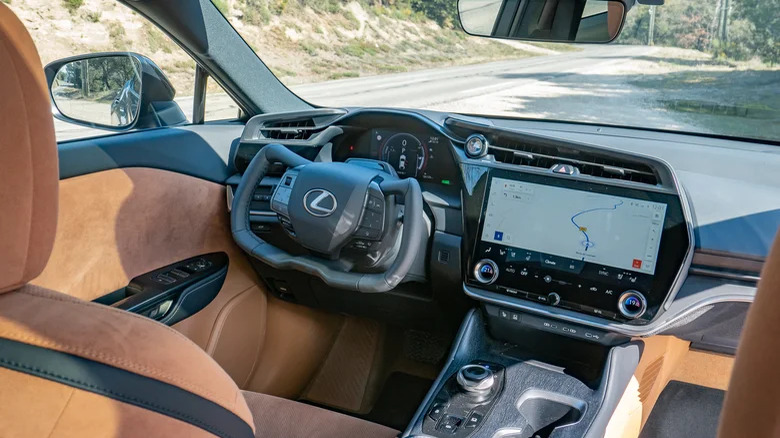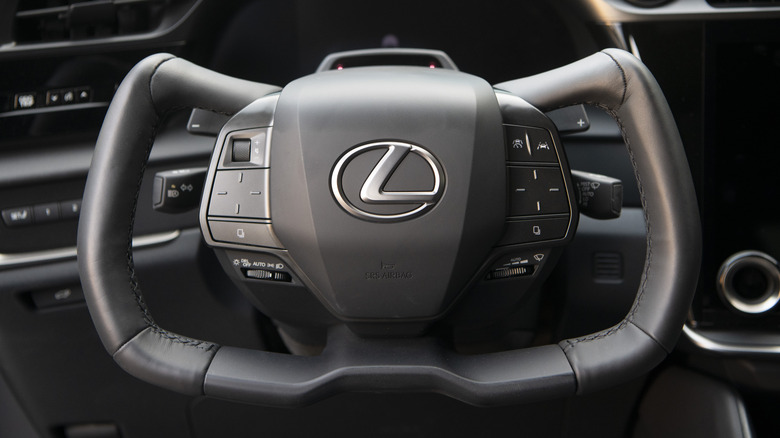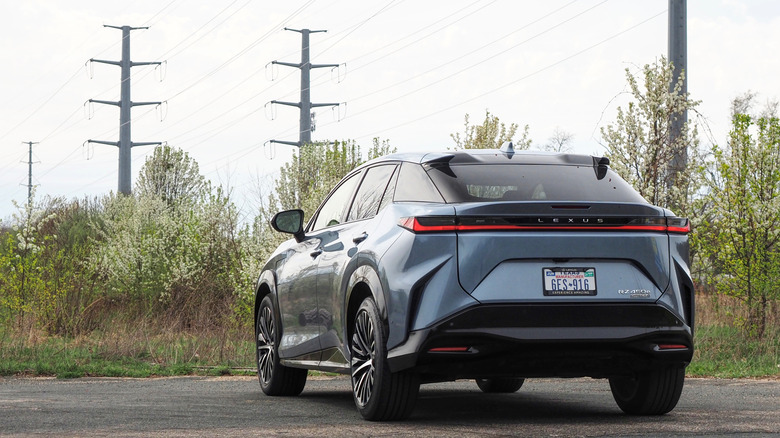What Is Lexus' Steer-By-Wire And How Does It Work?
Lexus turned some heads when it announced that the Lexus RZ, its first all-electric SUV, would be offered with a yoke steering wheel instead of the traditional circular one, but it's what's behind that oddly-shaped control that's actually the big change here. Lexus steer-by-wire — branded One Motion Grip in some regions — replaces the mechanical link you'd usually find connecting the steering wheel and the wheels. In doing so, Lexus says, it can offer a number of benefits.
For the Lexus RZ's yoke specifically, it helps address the smaller grip area. Usually, with a circular wheel, your hands can slide around the rim as you maneuver. With a yoke — which cuts the rim down to two much smaller sections — that's obviously not possible. In the case of Tesla's optional yoke on the Model S and Model X, that means twisting your arms to keep a grip in bigger turns.
Lexus gets around that by changing how much steering angle is applied, separate from the degree to which the yoke is turned. Because the wheel is effectively a digital input, the RZ can decide how much the steering angle is adjusted depending on factors like vehicle speed or where the driver's hands are.
Fewer turns of the wheel
A typical, traditional steering wheel can have anything from 900 to 1,200 degrees of rotation: effectively, you can turn the wheel fully two, three, or more times to adjust the steering angle from hard left to hard right. Lexus' steer-by-wire yoke, in contrast, requires just 150 degrees of rotation to go lock-to-lock. To make up for that reduction, a variable steering ratio is used, so that how much you turn the yoke at one vehicle speed may adjust the steering more or less than you do at another speed.
Variable steering ratios have been used before, but Lexus' is considerably more aggressive. If you're in a parking lot, for example, a small turn of the yoke will have an outsized impact on the steering angle. That's to make it easier to maneuver into spaces without doing lots of arm-over-arm turning. At higher speeds, meanwhile, Lexus slows the steering ratio down. That, the automaker says, leaves the RZ more stable when you're driving in a straight line on a highway, for example. The computers in the electric SUV are constantly assessing speed, steering inputs, and other factors, and adjusting the ratio accordingly.
You can still feel the road
It's not a one-way connection, either. The Steering Control Actuator that turns the steering rack, along with other sensors, can send feedback about road conditions — such as low surface traction or even if the wheels are about to lose grip altogether — to the Steering Torque Actuator that the yoke is connected to.
The controls can therefore adjust in overall weight, such as making the yoke firmer at low speeds, for example, but lighter at higher speeds. Drive mode can also be used as a criterion, such as making the steering easier to turn when the EV is set to Comfort, but cranking up the weight in Sport mode. The amount of road feedback can also be dialed-in depending on whether the driver is likely to want more isolation or to feel more connected to the surface.
Cutting out a mechanical link, only to replace the feeling that you'd get from it via artificial means, might sound a little ridiculous. Lexus' argument, however, is that it can better filter what sensations drivers might want to experience from what they'd prefer to ignore, like tire vibration or the bumps from low-quality road surfaces.
Building on existing technology
Breaking the mechanical connection between driver controls and how the car responds isn't a new idea. In fact, steer-by-wire systems have been available on production vehicles for a decade now. Infiniti's Direct Adaptive Steering launched in 2013 on the Q50 as an option, translating movement of the steering wheel to an actuator that adjusted the angle of the wheels.
Infiniti's argument is that the technology — still offered on cars like the Q50 and Q60 — avoids kickback from the road and wheels to the steering wheel, as well as allowing for different levels of steering personalization. In the Standard drive mode, for example, the steering is lighter; in Sport+ mode, the steering ratio can be quicker.
Brake-by-wire, meanwhile, is even more commonplace now. As with steering, it effectively translates the movement of the brake pedal electronically, adjusting the brakes accordingly, rather than relying on a solely 1:1 mechanical system. For electrified cars in particular, brake-by-wire leaves the vehicle to decide how it blends regenerative braking — where the electric motors operate as generators, slowing the car but also recharging the batteries — and traditional brakes for maximum overall efficiency.
Safety through duplication
Unlike how brake-by-wire still usually includes a hydraulic braking system as well, just in case the electronics fail, Lexus's steer-by-wire doesn't have a mechanical steering column as a backup. Instead, Lexus relies on electronic redundancy to cover potential system failures. There are duplicates of the hardware and software so that if the primary set suffers some calamity, the secondary system can kick in and make sure the RZ doesn't lose steering. Lexus also includes a separate battery, so that a power failure elsewhere in the SUV doesn't also take out the ability to steer the RZ to a safe stopping point.
It's a degree of redundancy we've seen autonomous car prototypes include, as automakers and others prepare for vehicles that do away with human drivers altogether. Though the Lexus RZ can't drive itself, it does offer features like Advanced Park, which enables the SUV to maneuver itself in and out of parallel and perpendicular parking spaces. Lane change assistance is also available as an enhancement to the adaptive cruise control with lane-keeping.
While RZ buyers in Europe will be able to order steer-by-wire from 2025, Lexus hasn't yet confirmed a release date for the option in North America. For now, buyers of the 2023 RZ 450e will just have to make do with a traditional, circular steering wheel.



